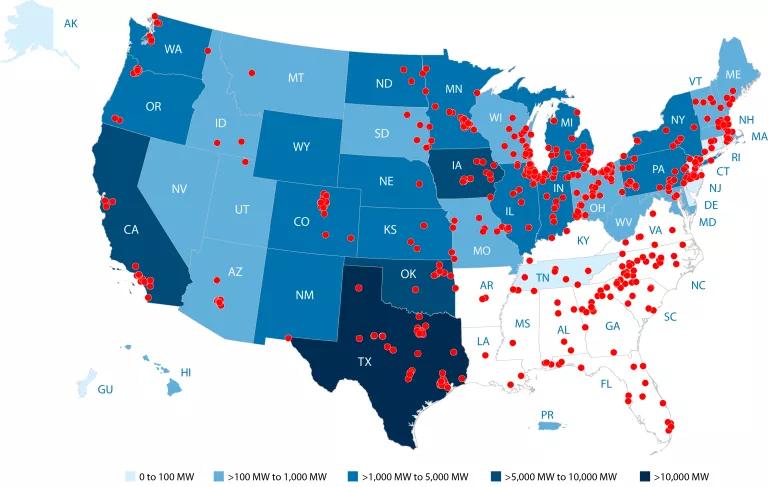NC Offshore Wind Power Auction Shows Clean Energy's Momentum

The U.S. Department of the Interior (DOI) yesterday auctioned off an offshore wind energy lease off North Carolina’s coast, the first-ever offshore wind auction in the Southeast. The wind energy area is located about 24 nautical miles east of North Carolina’s historic Kitty Hawk, where, in 1903, the Wright brothers and their pioneering technology first took flight. Avangrid Renewables, LLC, the American subsidiary of the Spanish electric company and wind power developer Iberdrola, is the winner. It paid more than $9 million for the lease, which can provide the company with the opportunity to build as many as 1,468 megawatts of offshore wind power—enough to power more than 500,000 homes.
The North Carolina auction, more broadly, also continues offshore wind power’s momentum toward a multi-billion dollar, clean energy industry investment along the Atlantic coast. “Renewable energy, like offshore wind, is one tool in the all-of-the-above energy toolbox that will help power America with domestic energy, securing energy independence, and bolstering the economy,” said Interior Secretary Ryan Zinke. “This is a big win for collaborative efforts with state, local, and private sector partners."
The success of this auction is great news for North Carolina, the Southeast, and the United States as a whole. In fact, the auction, with four bidders participating, demonstrates that despite current political and policy uncertainties at the federal and state level, developers see an increasingly bright future for the U.S. offshore wind industry overall. For more about the North Carolina auction process, here’s an informative blog post from our friends at the Southern Alliance for Clean Energy.

North Carolina’s and the region’s economies are the other winners in yesterday’s auction. The Southeast is already home to dozens of wind power-related manufacturing facilities. And with yesterday’s lease sale, residents come several important steps closer to the advantages that result from being one of the industry’s first movers, including the establishment of additional manufacturing facilities and other crucial elements of the offshore wind power supply chain. The U.S. Department of Energy (DOE) estimates that in North Carolina alone, offshore wind power can create as many as 1,450 new jobs by 2022; 10 times that many are possible in the state by 2050. In all, by mid-century, nationwide, offshore wind power can create 160,000 good jobs, both in the nation’s coastal regions and its interior, the DOE estimates. For more about the impact that offshore wind technology can have on North Carolina and the Southeast, read the upcoming post by my colleagues Katie Southworth and Luis Martinez.
Offshore wind power offers benefits that go far beyond jobs, as well. Because offshore wind power produces the most electricity when it’s needed most, it can help improve the reliability of local electric grids. And, of course, cleaner air means fewer trips to the emergency room.
In Europe, more than 12,600 megawatts of offshore wind power already produces enough electricity to power more than 8 million homes. The industry there employs tens of thousands of workers. Smart government policies have helped drive demand and lower costs. As a result, costs for the technology are dropping so fast there that some new offshore wind power projects are now increasingly cost-competitive with new fossil fuel projects on a levelized-cost basis.
In the United States, this fast-growing, multi-billion dollar industry is also taking off. This summer, Massachusetts enacted legislation that requires the Commonwealth to get 1,600 megawatts of offshore wind power by 2027. The nation’s first offshore wind power project, the Block Island Wind Farm, off the Rhode Island coast, came online in December, to great fanfare. Not long after, New York’s Governor Andrew Cuomo committed the Empire State to building 2,400 megawatts of offshore wind by 2030, enough to power 1.25 million homes. As a first step, Long Island’s power provider, LIPA, has approved a contract for a 90-megawatt project 30 miles east of Montauk, Long Island—the nation’s largest to date.
Progress hasn’t stopped there. California this month hosted two packed meetings about developing projects in deep coastal waters. In the last week, DOI received unsolicited lease requests from companies hoping to develop projects near New York and Massachusetts. And this week, Maryland’s Public Service Commission started hearings on proposals from two developers hoping to build projects off the coast of the Old Line State.

All together, including yesterday’s auction, DOI has held seven competitive lease sales and 13 lease sales in all, from North Carolina all the way up to Massachusetts. And, across the country, there are at least nine offshore wind power projects in the works, putting us on track to create highly skilled offshore wind jobs and build important new infrastructure.
All that is clean energy momentum, to be sure. With the Kitty Hawk Wind Energy Area auction yesterday, another important and pioneering technology really took flight.




